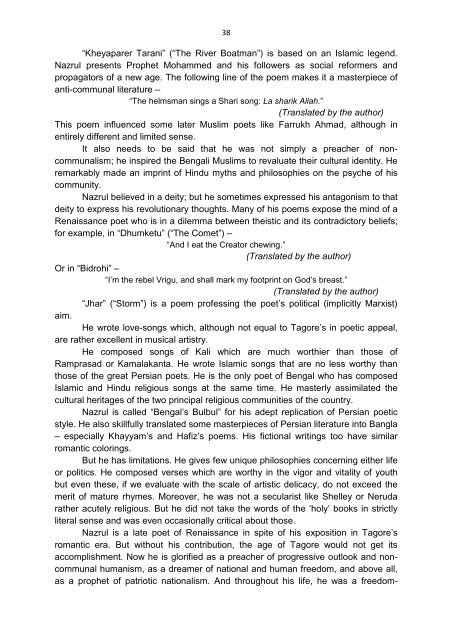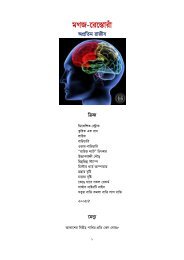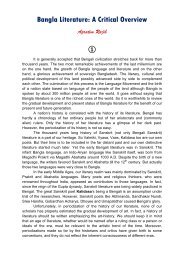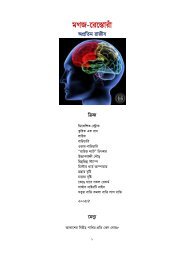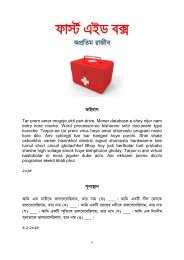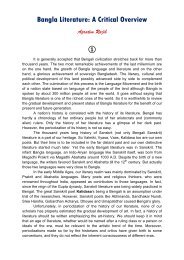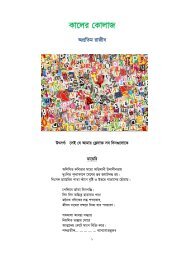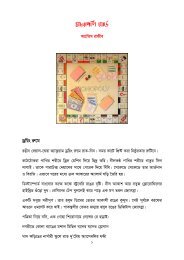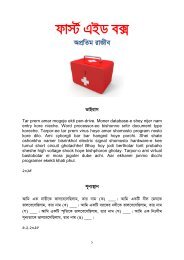BLiterature-Apratim
You also want an ePaper? Increase the reach of your titles
YUMPU automatically turns print PDFs into web optimized ePapers that Google loves.
38<br />
“Kheyaparer Tarani” (“The River Boatman”) is based on an Islamic legend.<br />
Nazrul presents Prophet Mohammed and his followers as social reformers and<br />
propagators of a new age. The following line of the poem makes it a masterpiece of<br />
anti-communal literature –<br />
“The helmsman sings a Shari song: La sharik Allah.”<br />
(Translated by the author)<br />
This poem influenced some later Muslim poets like Farrukh Ahmad, although in<br />
entirely different and limited sense.<br />
It also needs to be said that he was not simply a preacher of noncommunalism;<br />
he inspired the Bengali Muslims to revaluate their cultural identity. He<br />
remarkably made an imprint of Hindu myths and philosophies on the psyche of his<br />
community.<br />
Nazrul believed in a deity; but he sometimes expressed his antagonism to that<br />
deity to express his revolutionary thoughts. Many of his poems expose the mind of a<br />
Renaissance poet who is in a dilemma between theistic and its contradictory beliefs;<br />
for example, in “Dhumketu” (“The Comet”) –<br />
“And I eat the Creator chewing.”<br />
(Translated by the author)<br />
Or in “Bidrohi” –<br />
“I’m the rebel Vrigu, and shall mark my footprint on God’s breast.”<br />
(Translated by the author)<br />
“Jhar” (“Storm”) is a poem professing the poet’s political (implicitly Marxist)<br />
aim.<br />
He wrote love-songs which, although not equal to Tagore’s in poetic appeal,<br />
are rather excellent in musical artistry.<br />
He composed songs of Kali which are much worthier than those of<br />
Ramprasad or Kamalakanta. He wrote Islamic songs that are no less worthy than<br />
those of the great Persian poets. He is the only poet of Bengal who has composed<br />
Islamic and Hindu religious songs at the same time. He masterly assimilated the<br />
cultural heritages of the two principal religious communities of the country.<br />
Nazrul is called “Bengal’s Bulbul” for his adept replication of Persian poetic<br />
style. He also skillfully translated some masterpieces of Persian literature into Bangla<br />
– especially Khayyam’s and Hafiz’s poems. His fictional writings too have similar<br />
romantic colorings.<br />
But he has limitations. He gives few unique philosophies concerning either life<br />
or politics. He composed verses which are worthy in the vigor and vitality of youth<br />
but even these, if we evaluate with the scale of artistic delicacy, do not exceed the<br />
merit of mature rhymes. Moreover, he was not a secularist like Shelley or Neruda<br />
rather acutely religious. But he did not take the words of the ‘holy’ books in strictly<br />
literal sense and was even occasionally critical about those.<br />
Nazrul is a late poet of Renaissance in spite of his exposition in Tagore’s<br />
romantic era. But without his contribution, the age of Tagore would not get its<br />
accomplishment. Now he is glorified as a preacher of progressive outlook and noncommunal<br />
humanism, as a dreamer of national and human freedom, and above all,<br />
as a prophet of patriotic nationalism. And throughout his life, he was a freedom-


